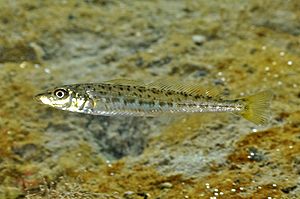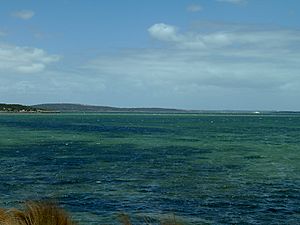King George whiting facts for kids
Quick facts for kids King George whiting |
|
|---|---|
 |
|
| Juvenile | |
| Conservation status | |
|
Not evaluated (IUCN 3.1)
|
|
| Scientific classification | |
| Kingdom: | |
| Phylum: | |
| Class: | |
| Order: | |
| Family: |
Sillaginidae
|
| Genus: |
Sillaginodes
T. N. Gill, 1861
|
| Species: |
S. punctatus
|
| Binomial name | |
| Sillaginodes punctatus (Cuvier, 1829)
|
|
 |
|
| Range of the King George whiting | |
| Synonyms | |
|
Sillaginodes punctata Cuvier, 1829 |
|
The King George whiting (Sillaginodes punctatus) is a special type of fish that lives in the ocean near the coast. It's also known as the spotted whiting because of its unique spots. This fish belongs to the smelt-whiting family, called Sillaginidae.
This amazing fish is found only in Australia. It lives along the southern coast, from Jurien Bay in Western Australia all the way to Botany Bay in New South Wales. The King George whiting is the only fish in its group, called Sillaginodes. It's also the biggest fish in the smelt-whiting family, growing up to 80 centimeters (about 31 inches) long and weighing up to 4.8 kilograms (about 10.5 pounds).
You can easily tell a King George whiting apart from other whiting fish by its special spot pattern and its long, thin body. These fish often live in bays and calm waters where there's sand and seagrass. As they get older, they might move to deeper parts of the ocean near reefs. They are carnivores, meaning they eat other animals like small crabs, worms, and other fish.
The King George whiting is very important for fishing in southern Australia. It's caught by both commercial fishing boats and people who fish for fun. Many people love to catch them because they are fun to reel in and taste delicious!
Contents
Discovering the King George Whiting
The King George whiting is the only fish in its group, or genus, called Sillaginodes. This group is part of the larger smelt-whiting family, Sillaginidae. These families are all part of an even bigger group of fish called Perciformes.
The first time this fish was officially named was in 1829 by a scientist named Georges Cuvier. He called it Sillago punctata. He found this fish in a place called King George Sound in Western Australia. Later, in 1861, another scientist named Theodore Gill created the special group Sillaginodes just for this fish because of its unique body features. He then gave it the name S. punctatus.
The most common name, "King George whiting," comes from the place where it was first found. It's also sometimes called the "spotted whiting" because of the brown spots on its body.
What Does a King George Whiting Look Like?
The King George whiting has a body shape similar to other whiting fish. It's long and a little flat, with a head that gets narrower towards the front and a mouth at the very end.
This fish is special because it has a first dorsal fin (the fin on its back) with 12 or 13 stiff spines. Its second dorsal fin has one spine and 25 to 27 soft rays. It also has between 42 and 44 bones in its spine, called vertebrae.
The King George whiting is the biggest fish in the Sillaginidae family. It has many scales along its side, usually between 129 and 147. One of the best ways to identify this fish is by its swim bladder. This is a special organ inside the fish that helps it float. The King George whiting's swim bladder looks a bit like a slug, with two horn-like parts at the front.
The color of the King George whiting also helps to identify it quickly. Its top half is usually a pale golden brown or olive brown, while its belly is white or silver. It has clear, slanted rows of brown spots along its body. These spots are easy to see even after the fish has been caught. Its tail, anal, and pectoral fins (the fins on its sides and bottom) are usually light brown, and sometimes the tail fin can be olive green.
This fish can grow quite large for its family, reaching up to 72 centimeters (about 28 inches) long and weighing up to 4.8 kilograms (about 10.5 pounds).
Where King George Whiting Live

King George whiting are found only in Southern Australia. They live in the waters off Western Australia, South Australia, Victoria, and sometimes even southern New South Wales. The furthest west they've been found is Jurien Bay, and the furthest east is Botany Bay.
These fish are most often found in bays, estuaries (where rivers meet the sea), and creeks along the coast. They also live around the many islands in their range.
Young King George whiting and adult fish live in different places. Young fish prefer shallower waters in protected bays, creeks, and estuaries. They especially like to hide and find food in beds of Zostera and Posidonia seagrass. These seagrass beds offer them protection from predators.
Young whiting often swim together in groups, sometimes even with other types of whiting. Adult fish tend to swim alone and live in deeper waters. You can find them in bays, near offshore beaches, and around deep reefs. They might also visit shallower waters sometimes.
King George Whiting Life and Habits
What King George Whiting Eat
The King George whiting's body shape and mouth are perfect for finding food on the ocean floor. This is how most whiting fish eat.
Larger whiting use their mouths, which can stretch out like a tube, to suck up different kinds of prey from the sand or mud. They don't seem to rely on their eyesight much when they hunt. Instead, they use vibrations from their prey to find them.
Studies of what's inside their stomachs show that King George whiting mostly eat small crustaceans like amphipods and copepods, as well as polychaete worms. Interestingly, unlike some of their relatives, King George whiting don't seem to eat molluscs (like cockles), even though cockles are a popular bait for catching them. This might be because the cockles are usually taken out of their shells when used as bait. Raw king prawns are also excellent bait.
They also rarely eat echinoderms, which are common food for other types of whiting. This might help different whiting species share the same habitat without competing too much for food. Other things they might eat include different types of shrimp, crabs, and even small fish or algae from the ocean floor.
Younger fish often hunt in groups, sometimes with other fish like white trevally, tarwhine, and other whiting species. Older fish tend to live in areas with bigger fish like Australasian snapper and blue morwong.
Who Eats King George Whiting?
Young King George whiting are often eaten by larger fish and wading birds. Some of their main predators in coastal waters include Australian salmon, flathead fish, barracouta, snook, and different kinds of sharks and rays.
Many diving birds, especially the Australian pied cormorant, also hunt King George whiting. Marine mammals like bottlenose dolphins and common dolphins are also known to eat them.
Reproduction and Life Cycle
King George whiting are ready to have babies when they are about three to four years old. Male fish are usually around 30 centimeters (about 12 inches) long when they reach this stage, and females are about 34 centimeters (about 13 inches) long. These sizes are used by fishing rules to make sure fish have a chance to reproduce before they are caught.
King George whiting lay their eggs (spawn) in different places. Some spawn in deeper water, up to 9 meters (about 30 feet) deep, while others lay their eggs in estuaries. The most common time for them to spawn is in May and June, but it can happen from February to July.
Young fish are carried to new areas by ocean currents because they are not strong swimmers over long distances. Where the fish spawn also affects where the young fish will grow up, especially for those born in estuaries.
King George Whiting and People
The King George whiting is a highly valued food fish in southern Australia. Because it's so common, it's a big part of both commercial fishing (where fish are caught to be sold) and recreational fishing (where people fish for fun). People have also looked into farming these fish, but it seems to be difficult.
Commercial Fishing
The main area for commercial King George whiting fishing is in South Australia, from Ceduna in the west to Gulf St Vincent in the east. There are also smaller fishing areas in Victoria and southwestern Western Australia. Fishermen use different methods to catch them, like large nets (seine nets and gill nets) and lines with many hooks (longlines and handlines).
This fishery is very important for Australia, bringing in over five million Australian dollars each year. King George whiting sell for a high price in markets. In the late 1980s, this one type of fish made up 60% of all fish caught in South Australia! The fish are sold whole or as fillets. Many people consider them one of the best tasting Australian fish, and you'll often find them in Fish and chips shops.
Recreational Fishing
In Southern Australia, many fishermen specifically try to catch King George whiting because they are so good to eat. Many coastal towns attract tourists who come to fish for them.
King George whiting are fairly easy to catch. You don't need special bait, fishing lines, or techniques. They can often be caught from jetties, beaches, and rocks, so you don't even need a boat. Simple fishing setups, like those with a sliding sinker or paternoster rigs, are commonly used.
As mentioned before, molluscs, especially the Goolwa cockle, are popular bait. Other successful baits include worms, maggots, squid, cuttlefish, pieces of fish, and especially raw king prawns. Larger whiting that live on deep reefs are sometimes caught using whole pilchards, especially when people are fishing for other fish like snapper.
Rules for catching King George whiting, like minimum size and how many you can catch, are different in each state.
- In Victoria, fish must be at least 27 centimeters (about 10.6 inches) long, and you can catch up to 20 fish per person.
- South Australia has two zones. East of a certain line, fish must be at least 32 centimeters (about 12.6 inches). West of that line, they must be at least 30 centimeters (about 11.8 inches). In both areas, you can catch up to 10 fish per person.
- Western Australia has a minimum size limit of 28 centimeters (about 11 inches) and a bag limit of 8 fish per person.
Aquaculture (Fish Farming)
Because King George whiting are so popular as food, people have studied whether they can be farmed. However, early studies show that their long larval stage (the time when they are very young fish) makes it hard to farm them successfully. Another problem is a parasite that only affects the fish when they are in captivity. Scientists are looking into using growth hormones to help the young fish grow faster, which might make farming them more possible in the future.
Images for kids
See also
 In Spanish: Silago manchado para niños
In Spanish: Silago manchado para niños


